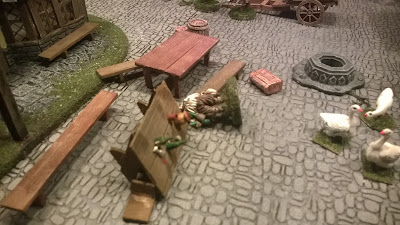Once more Osprey has released one of their little gems in the Osprey Wargames series. A Rennaissance successor to Ronin called En Garde is the latest addition.
En Garde is a tabletop skirmish wargame based on the
Ronin rules "engine" en set in the Rennaissance period. Meant to be
played with some 5-20 figures per side it covers the historical period from
around 1550 to 1750. That means fans of the Three Musketeers, Alatriste, the
Border Reivers and all kinds of small actions in the English Civil-, Thirty
Years- and Eighty Years War have finally found their ruleset!
 |
| Cardinal's Guards sneaking through an alley |
It is written in the standard Osprey format: A5 booklet in full colour across
64 pages providing a complete ruleset. Apart from the rules the book offers
special rules, army lists as diverse as Conquistadores and Aztecs, Musketeers and Turkish
Janissaries, scenarios and some tips on making your own army lists and reading.
But how does it play and how does it compare to its parent ruleset Ronin?
Just like in Ronin a turn has a Priority (Initiative + Morale) , Movement, Combat and End (Combat results) phase. The Action Phase however has been dismissed.
Also like Ronin the game has an alternate turn sequence. Players move their figures alternately starting with the player with highest Priority moving one first, then the other player moves one et cetera until all figures have been moved.
 |
| Aramis in serious trouble.... |
This achieves the same tactical depth in the game, as figures strive to maneuver into the best positions one by one. Unlike Ronin, En Garde enables group Activations by ordering groups around a Commander (an Attribute for high-ranking figures) to execute the same action all at once. Deadly musket volleys ensue!
 |
| D'Artagnan escaping through the back door of the tavern |
Missile weapons only fire once per turn in En Garde and usually must be reloaded, which also takes a turn. As the Action Phase has been removed, firing and reloading missile weapons now happens in the Move Phase instead of Moving or (modified) after a Short Move. Miscellaneous actions happen in this Phase as well, instead of or alongside a Move.
The terrific Combat system from Ronin has been transplanted and improved. While in Ronin combatants could use chits from their Combat Pool to simply enhance attacks or defences, in En Garde opponents may choose from a number of specific enhancements. Parries, Feints, Ripostes and Mighty Blows all cost Combat chits but deliver different benefits and penalties. Selecting your Combat Pool is now only the beginning.
This results in opposed die rolls where the difference between the rolls determines a succesful attack or defence. Only succesful attacks may cause damage and the larger the difference, the more serious the damage.
 |
| Poor old Planchet laid low by a musket volley |
In practice this results in a tense and quick game wherein a skilled Musketeer
can hold his own against a horde of knife-wielding ruffians, may play for time
by Feinting but may still be overwhelmed by their numbers before reinforcements
show up.
The black powder firearms are slow to reload, but have range and are especially lethal at short range. Interestingly, pistols may play a part in close combat.
The black powder firearms are slow to reload, but have range and are especially lethal at short range. Interestingly, pistols may play a part in close combat.
The book includes 8 scenarios and a simple campaign system. Inspiration for more scenarios is not hard to find in movies and books of the period. There are even tips for adding Fantasy elements like witches, werewolves and Revenants and a certain duo of large Barbarian and wiry Thief.
As yet untried is a simplified Attack procedure also included in the book to facilitate larger group actions.
Conclusion: like its predecessor Ronin En Garde is an interesting, quick playing game
with lots of athmosphere for the period it is placed in. Recommended!
I already have a Dutch Revolt table in mind.......
En Garde
64 pages paperback
By Craig Woodfield
Osprey Publishing 2016


